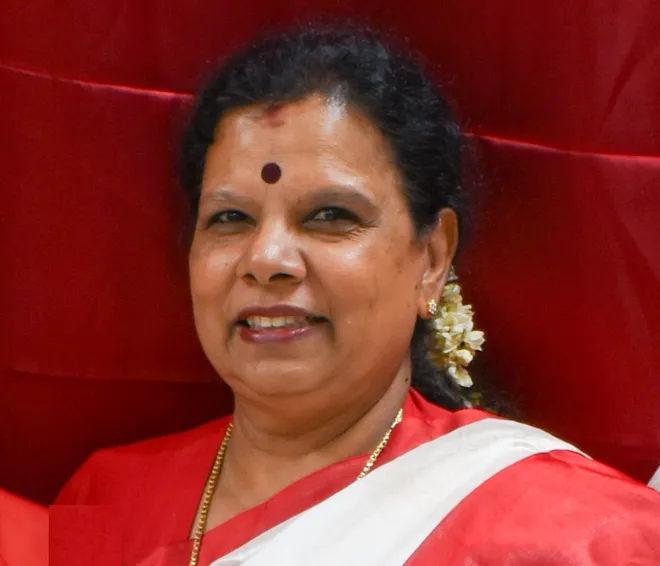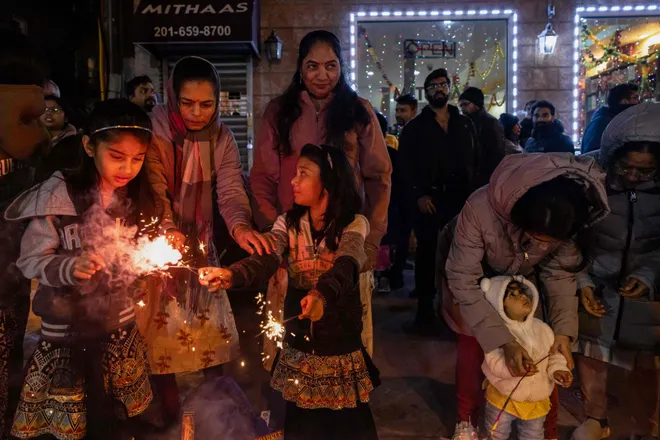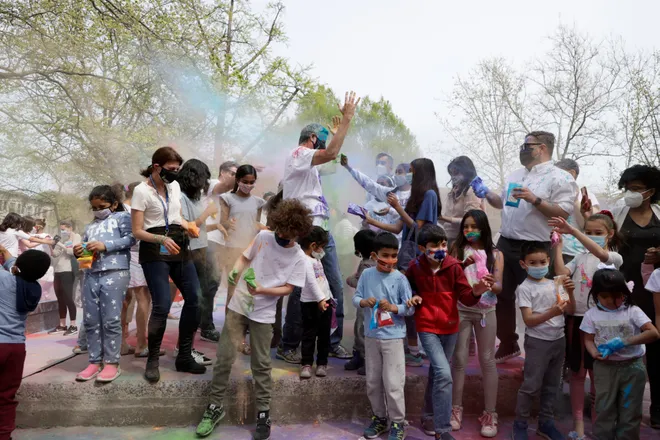For Hindu American youth puzzled by their faith, the Hindu Grandma is here to help.
She is wrapped in a traditional sari as she speaks, a kindly twinkle in her eye even as she seems to chide in an Instagram video posted in March.
“Kids often tell me they have no time for puja,” The Hindu Grandma says with a scolding finger, referencing a common Hindu prayer ritual. “They seem to have time for Instagram… TikTok…. But puja? Eh.”
But the petite, kindly woman ― whose real name is Ranjani Saigal ― has a solution. Today, she tells her viewers, she’ll demonstrate a brief version of the prayer, one “that can fit into anybody’s schedule.”
Six months ago, the 63-year-old former computer scientist had barely dipped her toes into the waters of social media; now, as The Hindu Grandma, she’s earned thousands of followers on Instagram and TikTok, sharing her knowledge of Hindu traditions and verses with Hindu youth and adults around the globe.
She personifies how social media has permeated so many facets of daily life - from idle chit-chat to religious teachings that, in some cases, simply aren't available anywhere else for the vast majority of people.
“It’s for them to understand the meaning of why we do something, so it’s not just hocus pocus,” she said. “Hindu traditions are so beautiful. It’s about celebrating and connecting with nature.”

Saigal hopes her daily videos, aimed at Hindu youth growing up in the U.S., give Hindu American parents another way to face the challenges of instilling faith traditions in their children in a country in which Hindus represent barely 1% of the population and misconceptions about the faith remain.
Her homey, upbeat videos range from explanations of Hindu stories and hymns or the meaning of the term “namaste” to details about her own journey. One of her most popular videos details the Hindu significance of lighting a lamp.
An estimated 2 to 3 million Hindus live in the U.S, according to Pew Research Center estimates; most are immigrants, largely South Asians from India, Sri Lanka, Bangladesh and Nepal. They are also young: More than a third of American Hindus are under age 30, according to a 2017 study by the Public Religion Research Institute.
Saigal originally came to the U.S. to attend grad school after earning an undergraduate engineering degree in India. Her career as a civil engineer and then computer scientist took her to Boston, where she’s now executive director of the U.S. arm of Ekal Vidyalaya, an organization that runs schools in remote areas of India and Nepal.
As a trained Hindu chaplain and instructor of South Indian classical dance, Saigal enjoyed sharing the underpinnings of her faith and culture with her American-born daughter, Amrita. Amrita Saigal and her husband ultimately hoped to pass on such knowledge to Saigal’s granddaughter, whose first birthday had already inspired Saigal to help write a children’s book, “My First Om.”
Eventually, Saigal said, Amrati urged her to share her knowledge with the world ― through mediums like TikTok and Instagram. Her daughter walked her through how the platforms worked and told Saigal she needed to come up with a handle. Saigal, perplexed, was as yet unconvinced.
“I said, ‘I don’t know who would care about a Hindu grandma,’” she said. “My daughter said, ‘That’s your handle.’”
At first, Saigal hoped for a few hundred followers. Her Instagram following now totals 146,000, with 17,000 more on TikTok.
“She’s always had a bubbly personality and knows so much about the traditions,” said Suhag Shukla, executive director of the Hindu American Foundation, a national organization based in Washington, D.C. “I love that she’s sharing her wisdom beyond her family. She’s having an impact.”
Stories of justice and action across America. Sign up for USA TODAY's This is America newsletter.
Struggling to instill Hindu faith traditions in American-born children
For Hindu American parents no longer immersed in Hindu societies, Ranjani’s presence as The Hindu Grandma demonstrates how social media has broadened the ways in which they can keep their faith traditions alive in their American-born children.
“When you’re a Hindu growing up in India or anyplace where you’re surrounded by Hindus, teachings and culture are passed on almost by osmosis,” said Shukla, of the Hindu American Foundation. “You’re never questioned about why you do things. You’re surrounded by people who share the same worldviews and practices.”

That dynamic changes in the U.S., where parents are challenged to explain rituals and beliefs in a world dominated by Judeo-Christian worldviews and tested by lingering misconceptions and stereotypes.
“I can’t even begin to tell you how much I got teased about eating monkey brains,” Shukla said, referencing a scene from the 1984 film “Indiana Jones and the Temple of Doom.”
While Shukla, who grew up in Northern California, recalls celebrating Diwali and other traditional festivals as a child at relatives’ homes or community centers, “we knew what we were doing but not why we were doing it ― and our parents were not equipped with answers.”
Her experience, growing up in the 1970s, was not uncommon. Consequently, programs similar to Christian Sunday schools sprung up at Hindu temples and community centers throughout the U.S.; so too did a handful of Hindu summer camps.
For youths straddling two cultures and looking for relevance in Hindu teachings, Shukla said, “those efforts have been extremely powerful in making sure you have second- and third-generation Hindu Americans.”
Shukla’s Hindu American Foundation, too, works to change misconceptions and to correct or supplement public schools’ often limited, Western views of Hinduism through textbook reform efforts or teacher trainings. It also produces materials that can help parents navigate difficult issues with their children from a Hindu perspective or that illustrate the impact of Hindu teachings on classic writers and artists such as Walt Whitman, Ralph Waldo Emerson and The Beatles.
“For a lot of young Hindu children, when you’re one percent of the population, you can internalize the idea of not being part of the fabric of the country,” Shukla said.

Another effort, near Houston, is the Texas Hindu Campsite, which offers youth a grounding in their Hindu heritage supplemented by outdoor activities to help them maintain their Hindu identity.
“The forces of assimilation are so strong, and unfortunately our Hindu American parents are fairly ignorant of their own culture and religion,” said camp founder Subhash Gupta. “They know some things, but they cannot explain to their children why they do these things or their importance. Children always question, and unless those curious minds are answered, it will not pass down.”
The profile of Hindus has been rising in the U.S., most recently with Usha Vance, whose husband JD Vance was chosen as Republican Presidential candidate Donald Trump’s running mate. Additionally, many practices that have gained footholds in the U.S. are rooted in Hinduism, Saigal said, including yoga, meditation and veganism.
She’s touched by how many people around the world have reached out to her, who now call her Nani, Dadi, Amma and other cultural terms of endearment used for grandmother.
“I am so grateful to God for making me an instrument in a unique way and grateful to my own mother for her teachings and blessings,” she said in a Hindu Grandma video posted on Mother’s Day.
With many relocated Hindus having started new families in the U.S with their grandmothers left behind in their homelands, Saigal hopes she’s helping to fill a void and a role in keeping Hindu faith traditions alive.
“It touches me so much when people say, ‘I can see my grandma in you,’” she said.
Disclaimer: The copyright of this article belongs to the original author. Reposting this article is solely for the purpose of information dissemination and does not constitute any investment advice. If there is any infringement, please contact us immediately. We will make corrections or deletions as necessary. Thank you.


